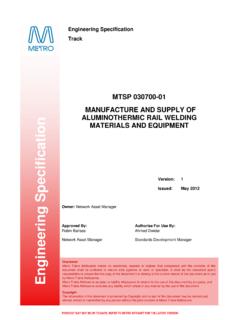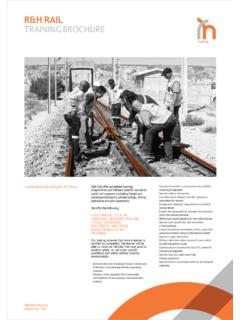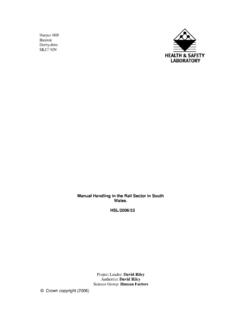Transcription of UNIVERSAL LIFTING BEAMS - Thomson Rail
1 Thomson ENGINEERING DESIGN Ltd UNIVERSAL LIFTING BEAMS Operators Manual Issue 08 November 2013 2 Index Safety Information 3 Safety Precautions 4 Risk Assessment 5 Operating Instructions 11 Attaching the UNIVERSAL beam 12 Setting the beam for use 14 Using the UNIVERSAL LIFTING beam 16 Detaching the UNIVERSAL beam 17 Routine Maintenance 18 Maintenance Schedule 19 Setting and Testing Procedure 20 Setting the valve operating pad 23 Data Sheets for Recommended Lubricants 24 Panolin Biogrease 2 25 Panolin HLP Synth 30 Technical Data 35 Hydraulic Hose Schedule 36 Hydraulic Rotator 37 Appendix A Engineering Acceptance Certificate Appendix B Product Acceptance Certificate 3 Safety Information 4 Safety Precautions Application of the Device The device is an attachment for use with a road/ rail excavator or
2 Similar machine The device is a piece of LIFTING equipment . The jaws of the device are designed for gripping and LIFTING Railway rail in order to lift either track panels or individual rails according to the angle of the heads. The device is not designed to be used in any other application. Risk of injury When attaching or detaching hydraulic connections When working on hydraulic system When LIFTING track panels When handling rail When releasing load When attaching or detaching the device to or from the road rail machine When close to moving parts Environmental Warnings Hydraulic oil can be dangerous to the environment and must be handled with care. Waste oil should be disposed of properly in accordance with manufacturer s recommendations.
3 Thomson Engineering Design recommends the use of PANOLIN biodegradable oils and greases. Each of the risks listed above is described in more detail in the following pages. 5 UNIVERSAL LIFTING beam Risk Assessment Introduction In compiling this risk assessment it was immediately obvious that there are three distinct sets of risks associated with a) operation, b) LIFTING and handling and c) repair and maintenance. It has therefore been decided to create this document as a three-part risk assessment with one section for each of the above. For each risk identified there is a short explanation and the means of limiting this risk is described. Where these details relate to the construction of the machine there is no further documentation.
4 Most of the operating risks, however, are also highlighted in the operator's manual supplied with the machine. Great emphasis is placed on the use of warning markings, operator training and red paint colouring to reduce the risks associated with the operation of the machine. Guarding of moving parts might seem preferable but the work carried out by the UNIVERSAL LIFTING beam , often at night and in poor weather conditions, by an operator who is already at some distance from the working parts and who must have as clear a view as possible of what he is doing is of a special nature. It was therefore decided to adopt a more basic approach to reducing the risk to personnel by using colour and visual warnings in order to keep personnel away from the machine.
5 It should be stressed that, whilst the risk assessments laid out below include some consideration of the risks of working the machine under on-site conditions this should not be taken as a thorough risk assessment of the site operation as other equipment and processes, not considered herein, may affect the overall risk profile of the operation. Specific application risk assessments should be carried out for site operations and these should be identified in any method statements or pre-planned work notes. 6 Operating Risk Assessment General Hydraulic Leakage (personal injury) High-pressure hydraulic systems are used on this machine. Damage or failure of hoses, pipes and fittings may cause a high-pressure jet of oil to be emitted from the system.
6 This could be hazardous to eyes, skin, etc. Pools of leaked oil could lead to an increased risk of slips, trips or falls. Connecting and disconnecting the supply and return hoses to the hydraulic systems of the prime mover carries a risk that oil may be spilled. All hoses fitted to this machine have a burst pressure in excess of twice the specified working pressure. Regular monitoring of the dimensions of the ferrules fitted to the hoses and careful training of the staff employed to make up hoses ensures that hose specifications are consistent. All components used in the hydraulic system are CE marked. Before working on the hydraulic system, minimise the pressure within the hydraulic system by setting the hydraulic cylinders to the mid point of their movement and disconnecting the device from the road/ rail machine.
7 Place a rag over any fitting whilst undoing it in order to help prevent a high-pressure jet being released towards skin or eyes. Hydraulic Leakage (physical) Exposure to hydraulic oil may cause dermatitis and may be a contributory factor in the development of skin cancer in certain individuals. Leakage from high-pressure systems may be in the form of a high velocity jet with the power to penetrate skin and/or cause injury to eyes, etc. Hydraulic oil is frequently very hot in use with consequent risk of burns or scalds. Operators and service personnel should wear appropriate protective equipment , especially gloves, goggles and overalls. Skin exposed to hydraulic oils should be washed as soon as possible.
8 The use of barrier creams is recommended. All personnel should be made aware of the contents of the COSHH data sheets relating to the hydraulic fluid in use. 7 Hydraulic Leakage (environmental) The potential environmental impact of oil spillage is considerable. Oil contamination is hard to treat and costly. Thomson Engineering Design recommends the use of biodegradable oils and greases such as those produced by Panolin and the use of such products is part of the manufacturer s standard specification. Falling Objects With any LIFTING device there is a risk that failure of the device, improper use, lack of or ineffective maintenance or poor working practices may cause the load to be released with consequent risk of serious or fatal injury.
9 The UNIVERSAL LIFTING beam is proof tested to 20 tonnes prior to despatch from the factory. It is strongly recommended that the device be re-tested at least every six months. A test procedure is included later in this documentation. A hydraulic valve is fitted to the UNIVERSAL LIFTING BEAMS , which prevents the grab jaws from being opened whilst carrying the load. However, this valve may be bypassed by placing the control lever in the red position (see operating instructions later in this documentation). Whenever possible the control lever should be placed in the GREEN position. All personnel must be kept well clear whilst LIFTING operations are in progress. All personnel in the vicinity of LIFTING works must wear appropriate PPE including hard hats.
10 Falling Sleepers and Ballast The UNIVERSAL LIFTING beam is commonly used to remove old track panels. It is possible that the rail fixings and/or sleepers may be so degraded that sleepers may fall from the track panel whilst it is elevated with consequent risk of serious injury. Ballast lying on the sleepers may fall as the panel is lifted with consequent risk of injury. All personnel must be kept clear whilst operating the device. All personnel in the vicinity of LIFTING works must wear appropriate PPE including hard hats. Moving rail When used for handling rail , the swinging and whipping of lengths of rail could cause serious injury. Keep all personnel well clear of the work area.







